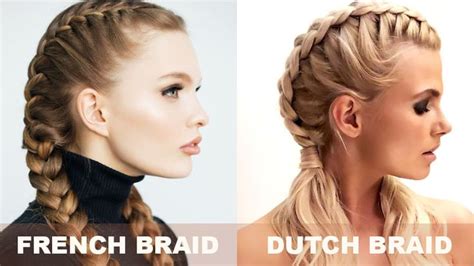Introduction
The world of hairstyling boasts a vast array of braiding techniques, each with its unique charm and versatility. Among the most popular and beloved are the Dutch braid and the French braid, two intricate plaits that have graced countless heads throughout history. This comprehensive guide will delve into the intricate details of each braid, comparing their techniques, aesthetics, and suitability for various occasions. So, prepare to embark on a braiding adventure as we unravel the key differences between the Dutch braid and the French braid.

Dutch Braid: A Technique of Dutch Origin
The Dutch braid, also known as an inside-out braid or a reverse French braid, originated in the Netherlands, hence its moniker. This braid stands apart from other braiding methods by its unique technique, which involves crossing the side strands under the center strand instead of over it. This technique creates a distinctive raised effect, visually resembling a basket weave.
French Braid: A Timeless French Tradition
The French braid, a staple in the hairstyling world, has its roots in the vibrant streets of France. This braid is characterized by its classic overhand weaving technique. By crossing the side strands over the center strand, the French braid forms an intricate pattern that evokes a sense of timeless elegance.
Comparative Techniques: Side by Side
To fully grasp the differences between these two braiding techniques, a side-by-side comparison is essential:
| Feature | Dutch Braid | French Braid |
|---|---|---|
| Strand Crossing | Under the center strand | Over the center strand |
| Visual Effect | Raised, basket-weave appearance | Flat, intricate pattern |
| Weaving Direction | Forward, towards the center | Backward, away from the center |
Aesthetics and Versatility: Personalizing Your Style
When selecting the perfect braid for your occasion, it’s crucial to consider the aesthetic qualities and versatility of each technique:
| Characteristic | Dutch Braid | French Braid |
|---|---|---|
| Style | Bold, eye-catching | Classic, timeless |
| Suitability | Casual and formal | Formal and semi-formal |
| Versatility | Can be worn in various sizes and positions | Typically worn in a single position |
Dutch Braid: A Bold and Versatile Masterpiece
The Dutch braid exudes a bold and distinctive character. Its raised appearance adds volume to the hair, making it an ideal choice for creating statement looks. Whether worn as a single braid, a crown braid, or a fishtail braid, the Dutch braid is a versatile style that can transform any occasion.
French Braid: A Classic with Endless Charm
The French braid, with its intricate overhand weave, is a timeless classic. It evokes an air of elegance and sophistication, making it a favorite for formal events. While it may not possess the same level of versatility as the Dutch braid, the French braid remains a graceful and enchanting style.
Choosing the Perfect Braid: A Matter of Occasion and Preference
The choice between a Dutch braid and a French braid ultimately depends on the occasion and personal preference. For bold and eye-catching looks, the Dutch braid is an excellent choice. For classic and elegant events, the French braid remains a sophisticated favorite.
Beyond Aesthetics: The Role of Braids in History and Culture
Throughout history, braids have played a significant role in various cultures around the world. They have been used to symbolize social status, religious beliefs, and cultural identity. For example, in ancient Egypt, women wore elaborate braids adorned with beads and jewels, while in Victorian England, braids were a sign of modesty and respectability.
Contemporary Applications: Braids in Modern Society
In contemporary society, braids continue to hold cultural and aesthetic significance. They are embraced by people of diverse backgrounds and styles, from celebrities to everyday individuals. Braids have also found innovative applications in industries such as fashion, beauty, and sports, inspiring countless hair care products and accessories.
Embracing Braiding Techniques: A Guide for Beginners
If you’re new to the world of braiding, don’t fret! Mastering these techniques takes time and practice. Here are a few tips to help you get started:
- Start with simple braids: Begin with basic three-strand braids before attempting more complex styles.
- Practice regularly: Dedicate time to practicing your braiding skills. The more you practice, the more proficient you’ll become.
- Use a mirror: If you’re a visual learner, use a mirror to observe your braiding technique and correct any errors.
- Seek inspiration from tutorials: There are numerous online tutorials available to guide you through various braiding techniques.
Ethical Considerations: Respecting Cultural Traditions
When incorporating braids into your hairstyles, it’s essential to be mindful of cultural sensitivities and avoid perpetuating stereotypes. Show respect for the cultural origins of braiding techniques by acknowledging their history and significance.
Conclusion
The Dutch braid and the French braid stand as iconic hairstyling techniques, each with its unique characteristics and appeal. While the Dutch braid offers a bold and eye-catching look, the French braid exudes timeless elegance. Ultimately, the choice between these two braids depends on personal preference and the occasion. Whether you’re a seasoned pro or a braiding novice, embracing these techniques will elevate your hairstyling repertoire and add a touch of versatility and beauty to your look.
